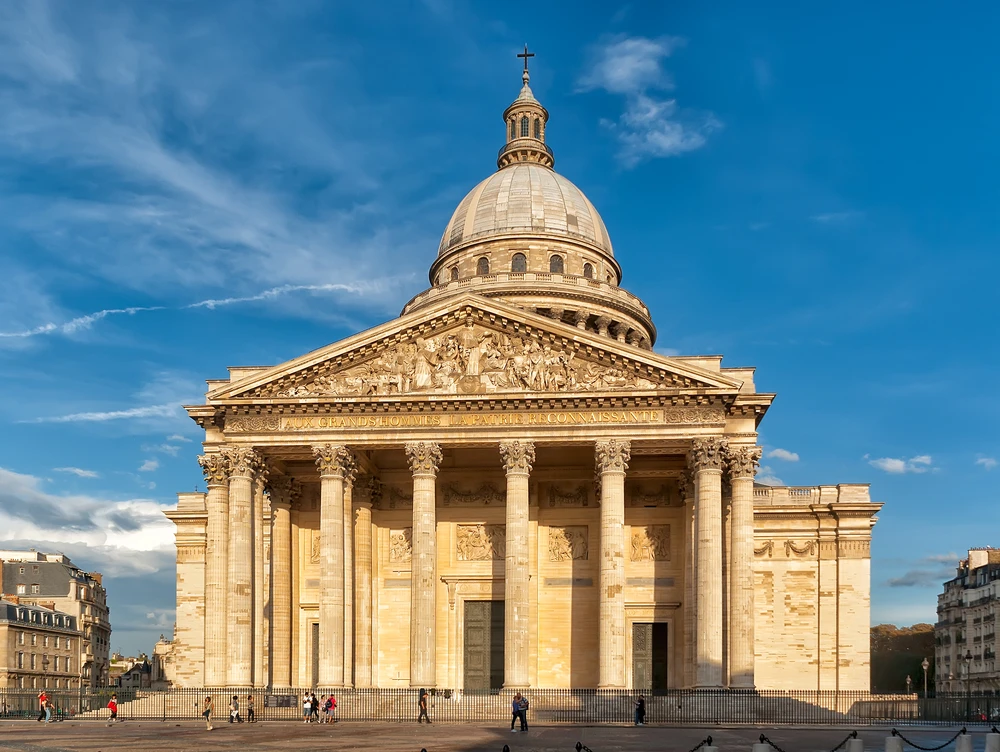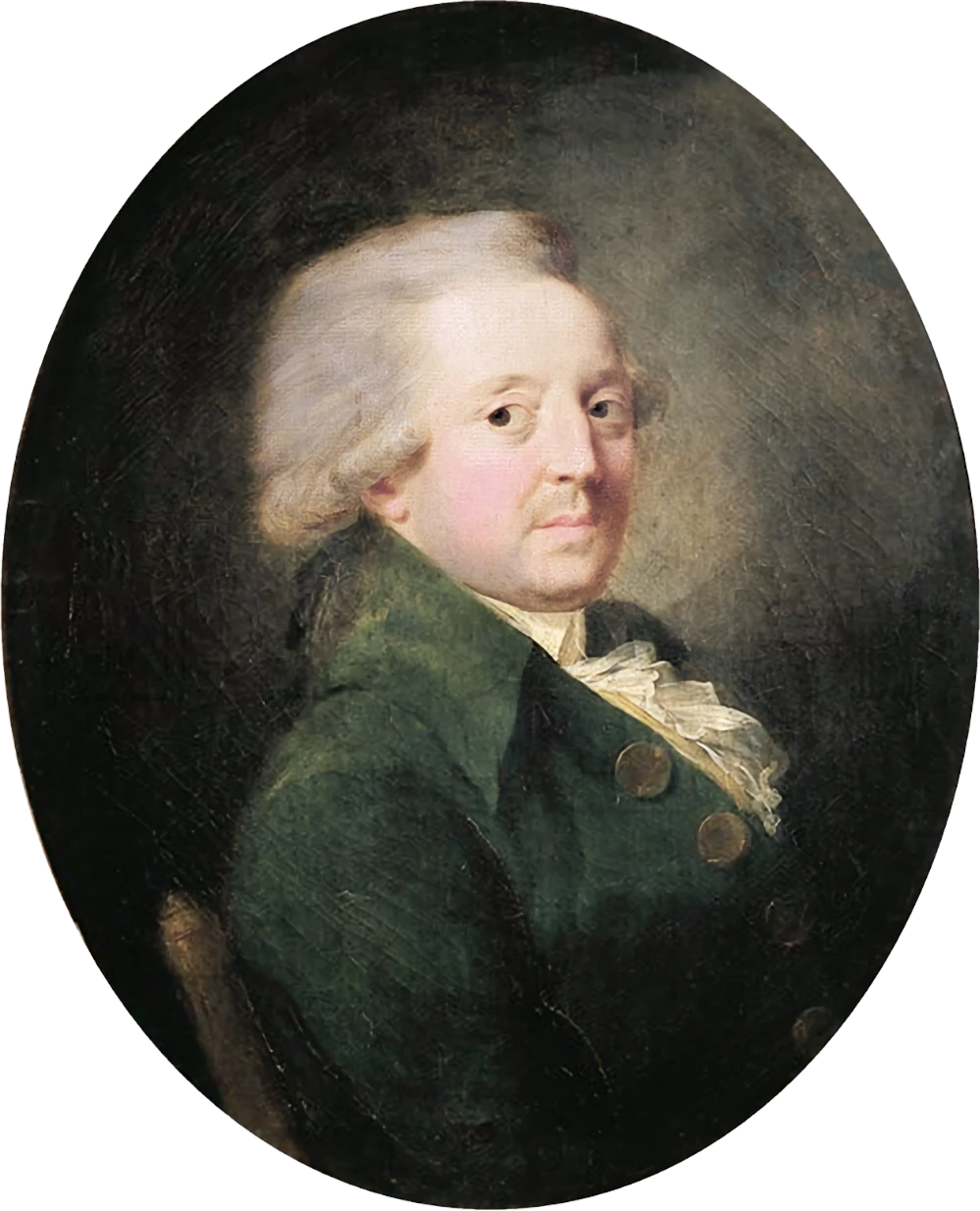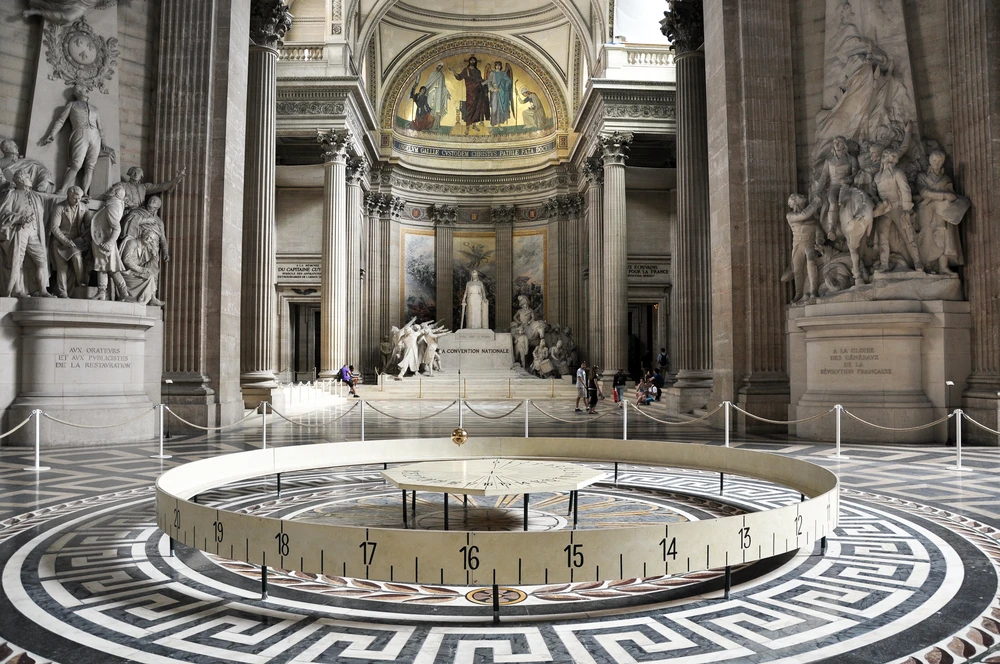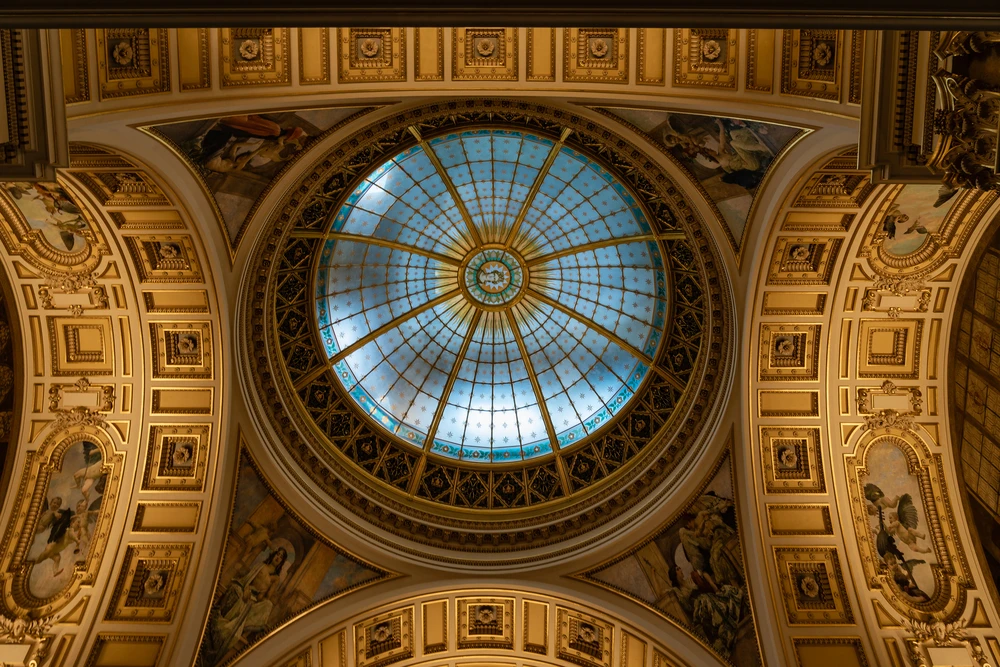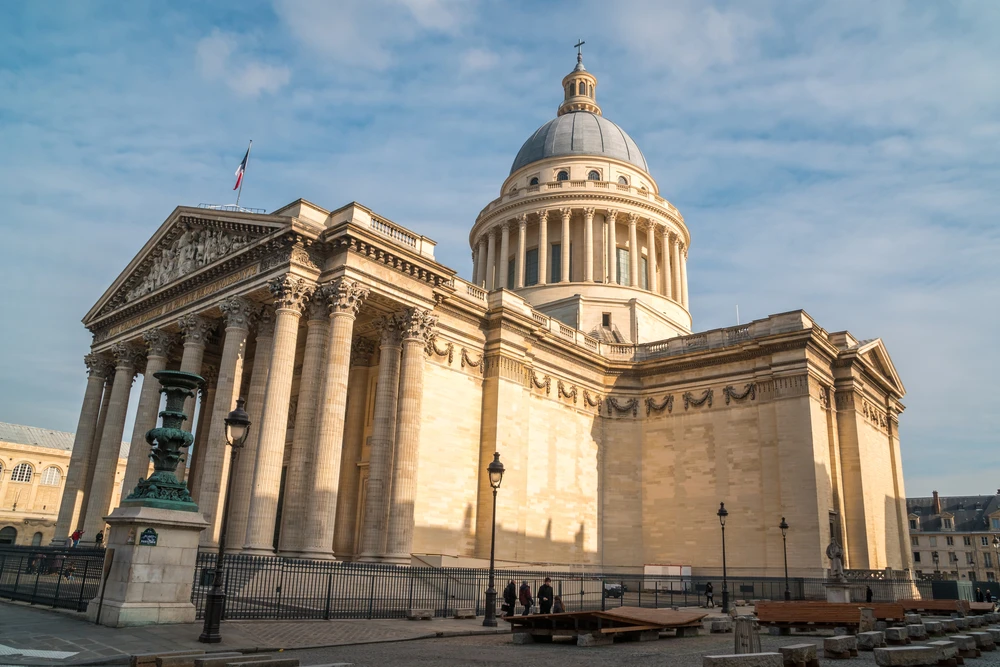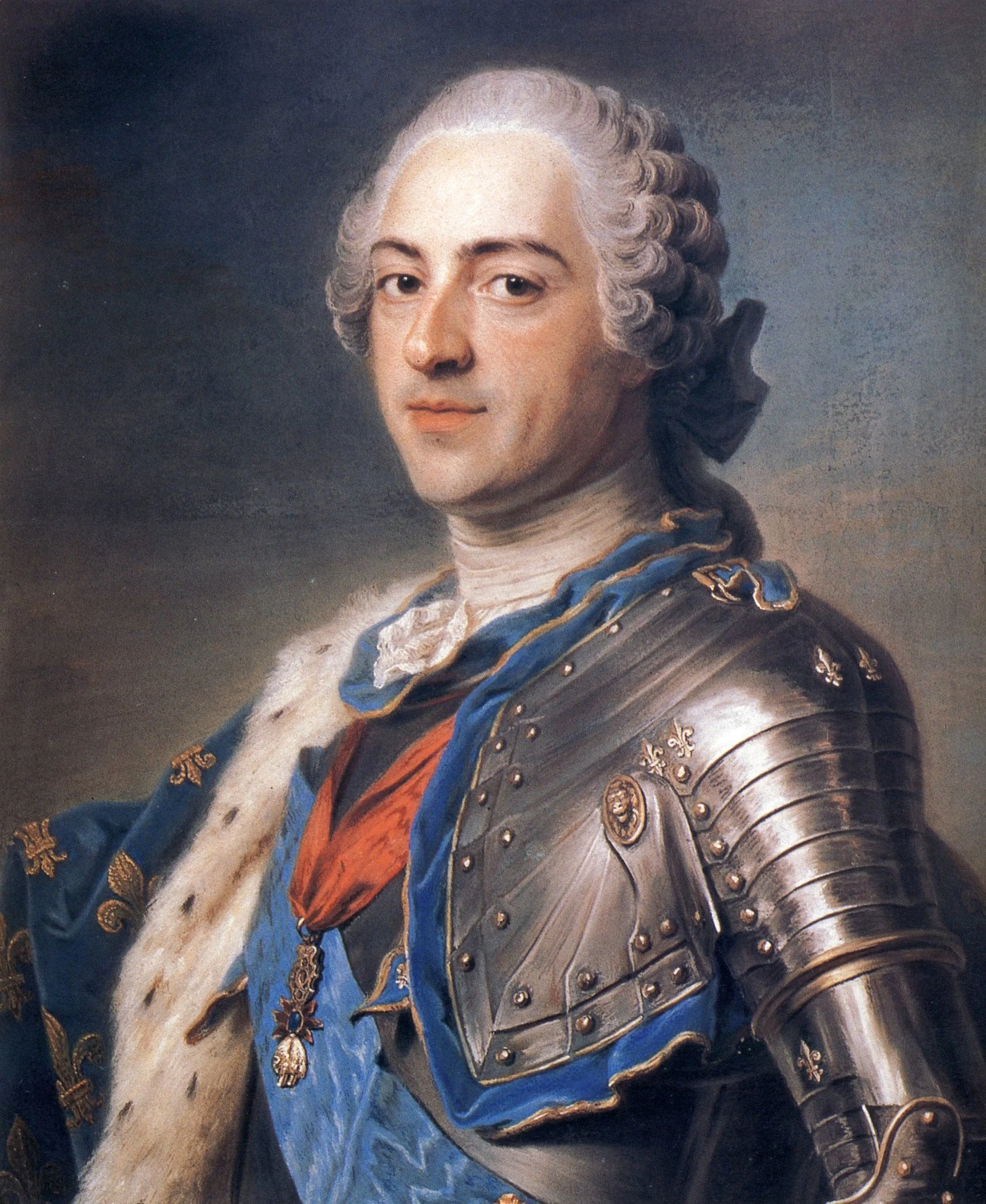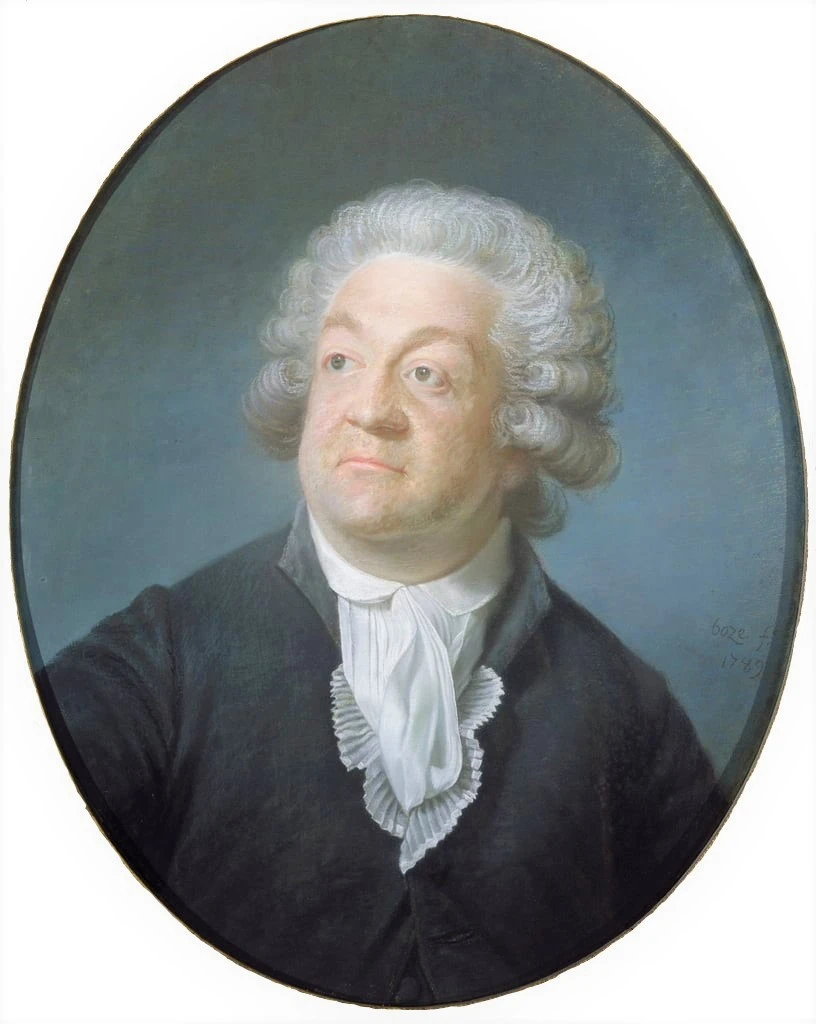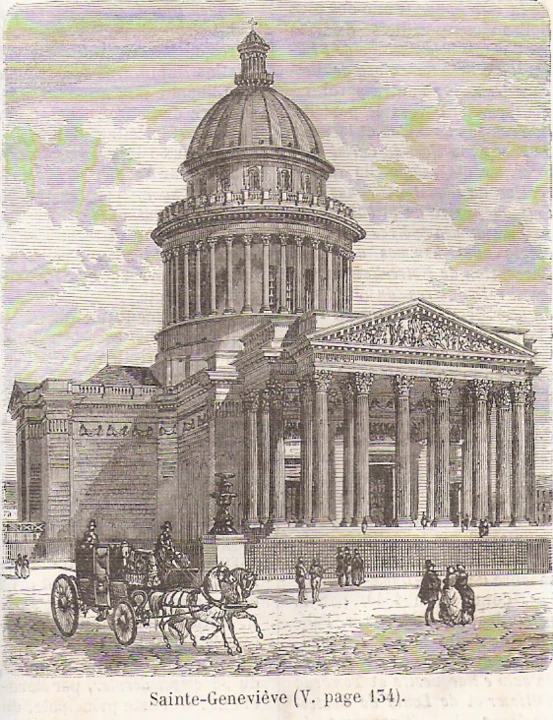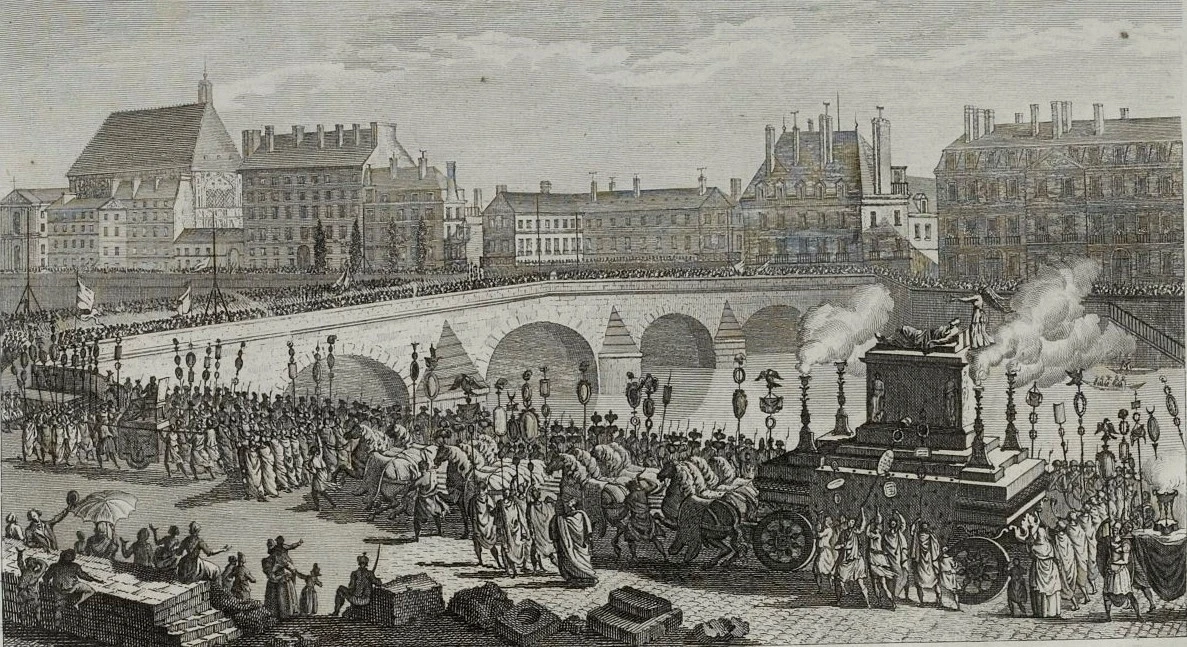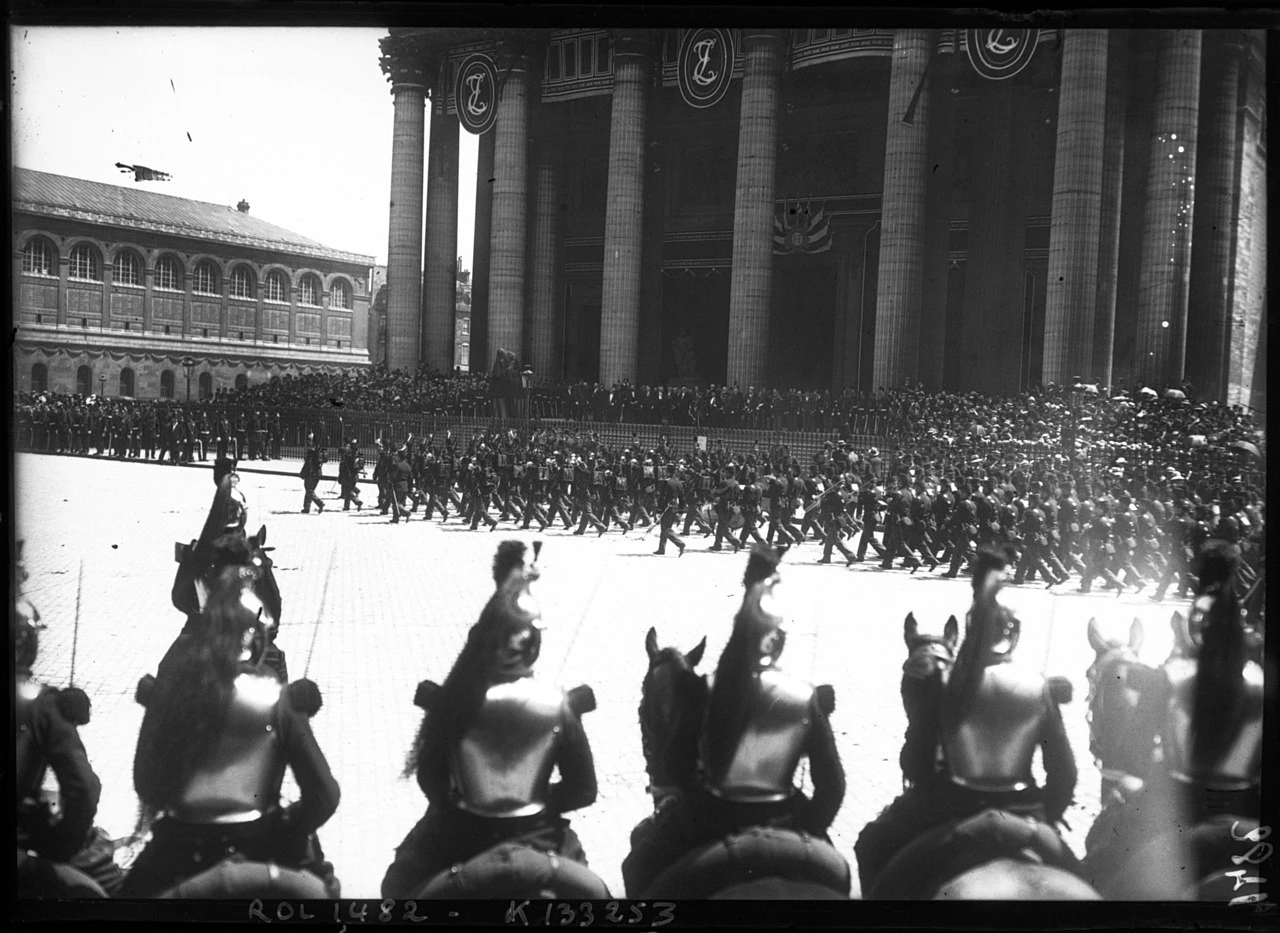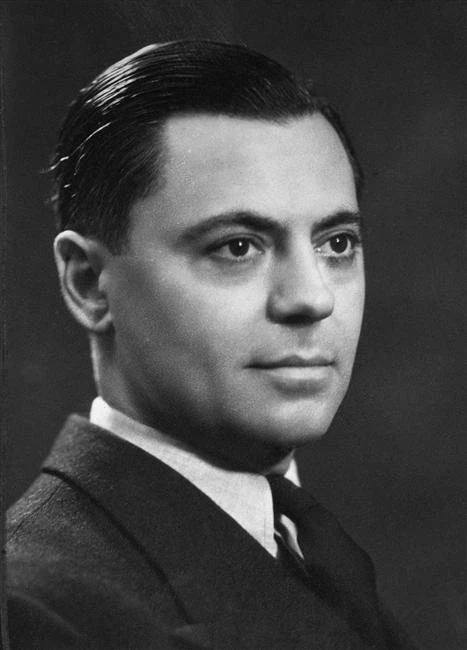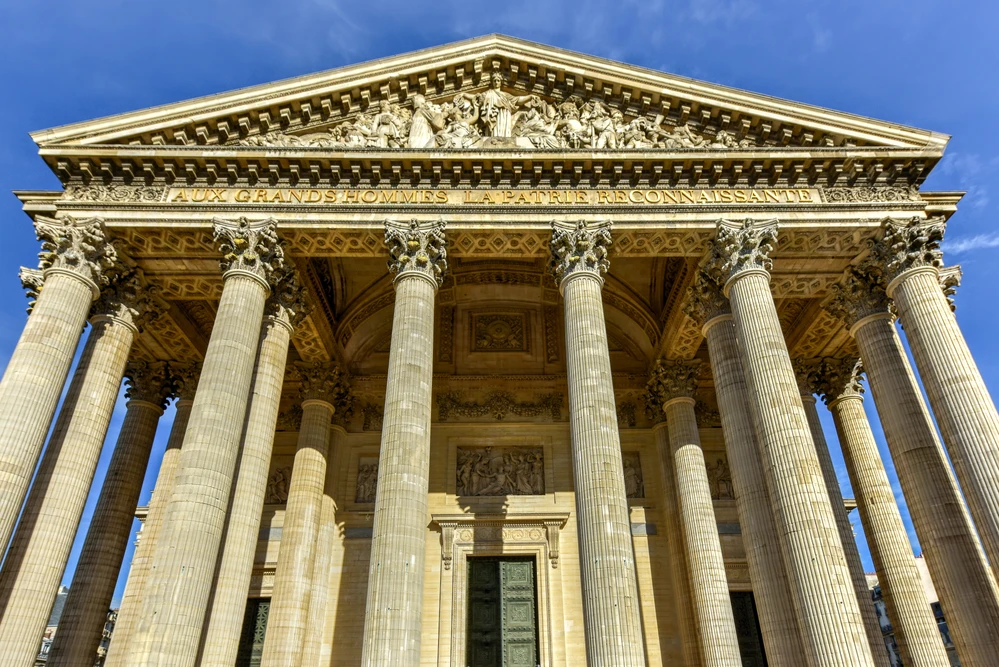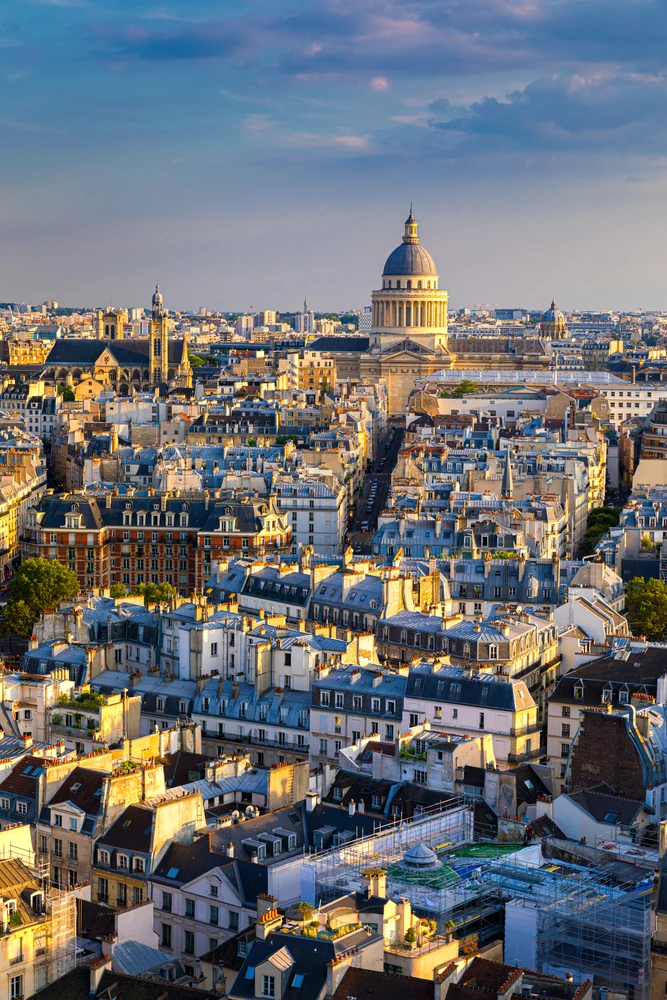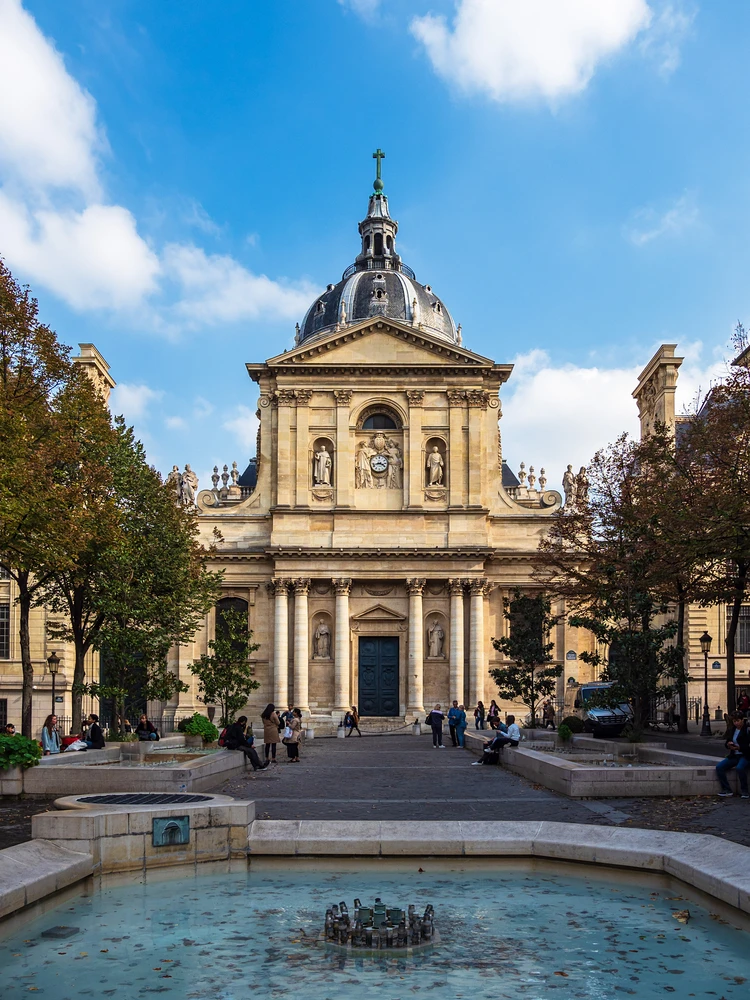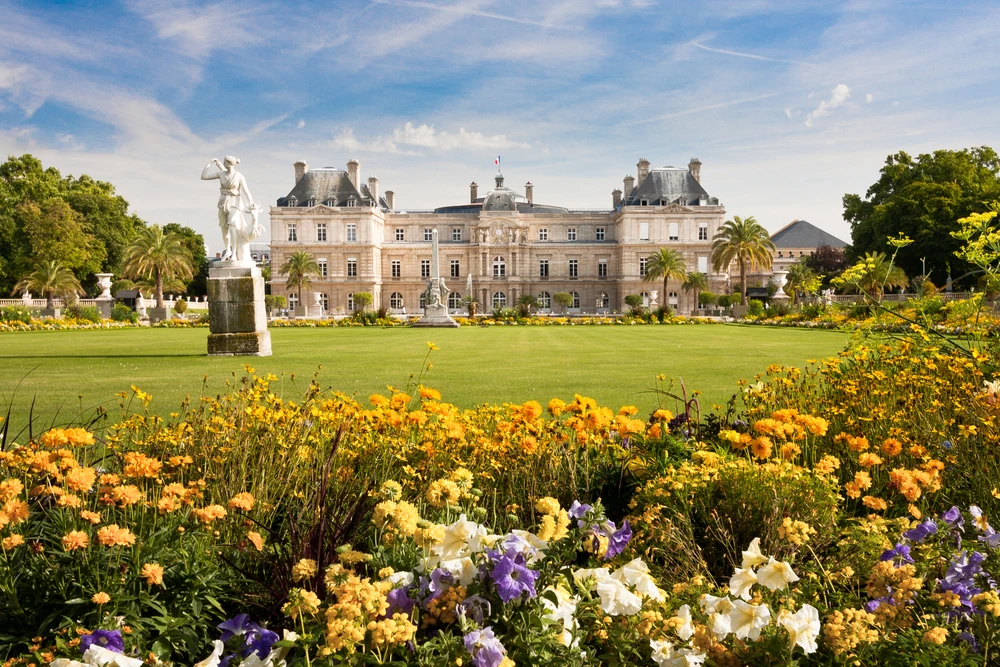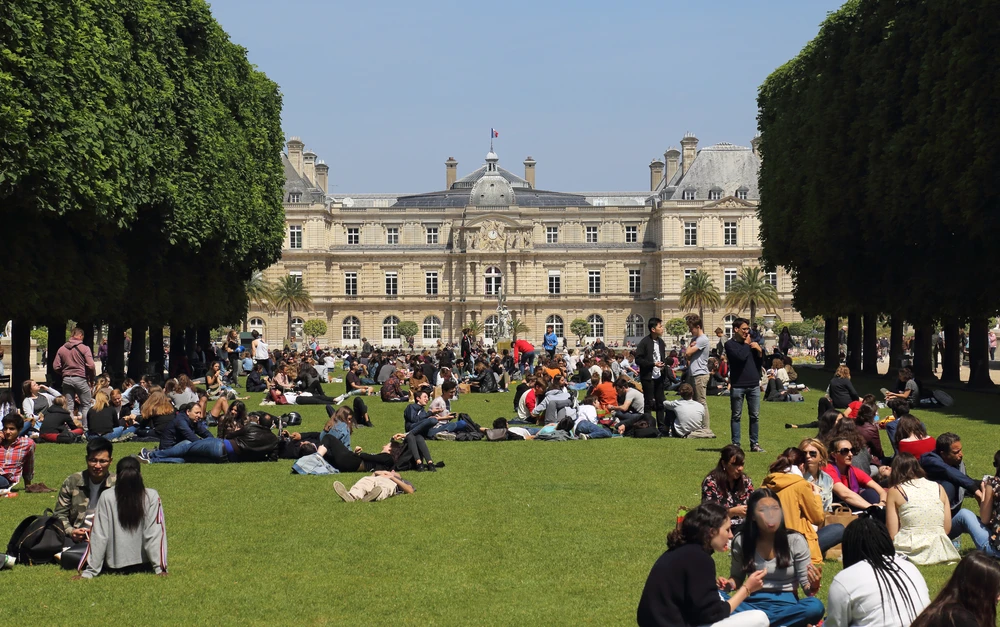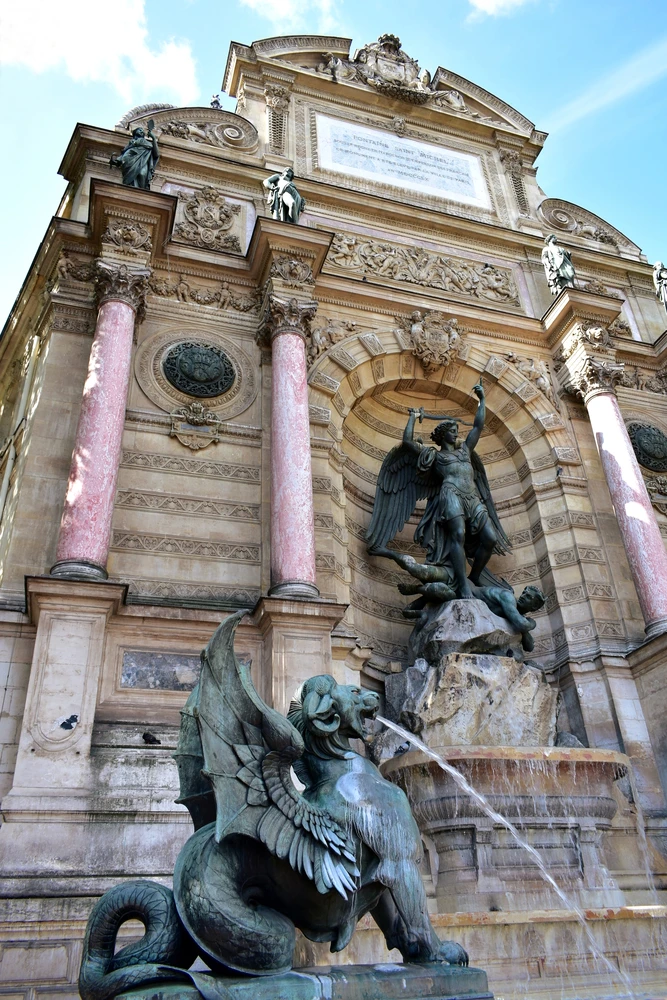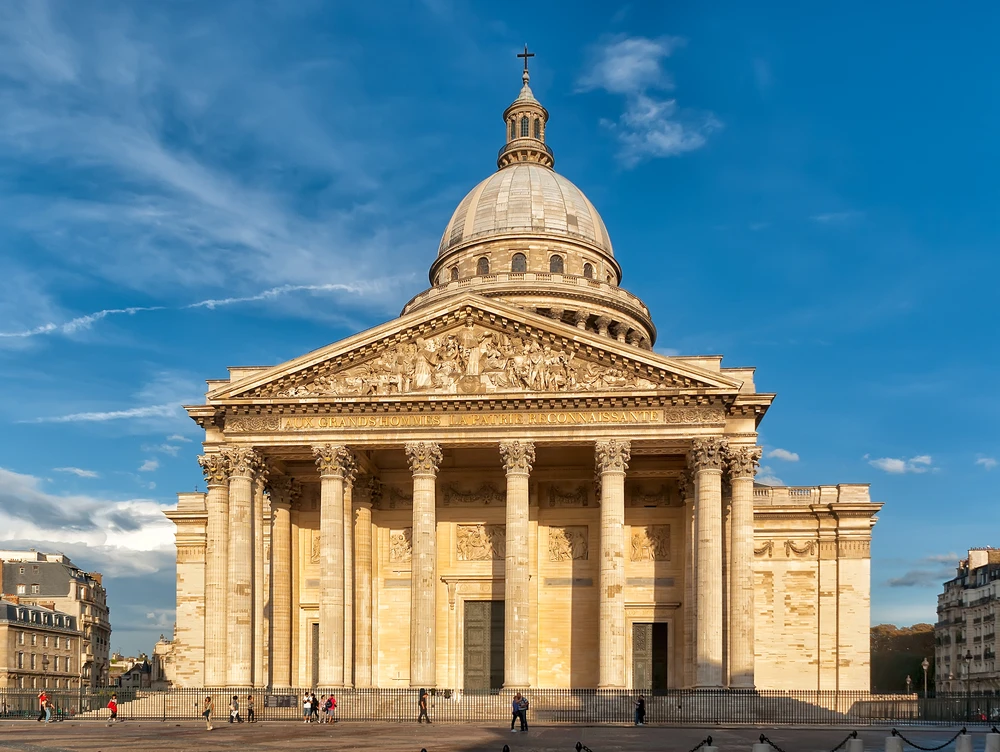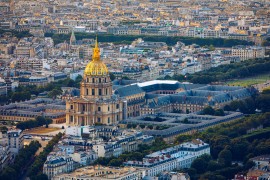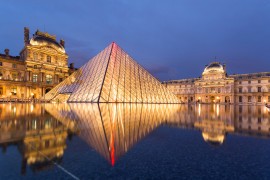The Pantheon - what's there to see?
The facade of the Panthéon and the dome in the background. Photo chosen by monsieurdefrance.com: Mix7777 via depositphotos.
Pantheon figures
The Paris Pantheon (not to be confused with the almost 2,000-year-old Pantheon in Rome) is 110 metres long and 84 metres wide in front of the colonnade. The dome, made entirely of stone, rises to a height of 83 metres, a feat of 17th-century architecture made possible by three interlocking domes weighing a total of 17,000 tonnes. Begun in 1764, it was completed in 1790. It holds 81 coffins. An average of 700,000 people visit it every year.
The crypt and the coffins (full... or empty!) at the Panthéon
Nicolas de Condorcet (1743-1794), whose body was never found but who is honored by an empty coffin at the Panthéon. Source Monsieurdefrance.com : wikipedia.
You can visit the crypt, where great men and women are laid to rest. VOLTAIRE and Jean Jacques ROUSSEAU are the oldest "residents". Marie CURIE was the first woman to enter on her own merits (her coffin is leaded because her X-ray research irradiated her body). Some coffins are empty. This was the case for CONDORCET, who was guillotined during the French Revolution, and whose body was never found. Jean MOULIN's ashes are his "supposed" ashes. The same is true of Germaine TILLON and Geneviève de GAULLE-ANTHONIOZ, whose coffins contain a small amount of earth taken from their graves. The great resistance fighter was martyred on a train, and we're not sure it was his body that was cremated. The ashes are mixed with sand. There is also a body in the hands, that of Louis BRAILLE, inventor of the alphabet for the blind and visually impaired, "pantheonized" in 1952. His hands remain in the Coupvray cemetery, where he was laid to rest for many years. There are also body "parts", such as Léon GAMBETTA's heart, installed in 1920. That said, many entered under the Empire and are, for the most part, largely forgotten.
Marie CURIE by Pierre MANUEL circa 1920.
The plaques that honor the Panthéon.
In the nave of the Panthéon, we also discover plaques honoring. Aimé CESAIRE, the great author and champion of "négritude", Antoine de SAINT-EXUPERY, author of "Le Petit Prince". There are also collective plaques. For example, the 550 writers who died for France (including Charles PEGUY), or the 2,700 Justes who risked their lives to protect Jews during the Second World War. Some personalities are honored twice, since their bodies lie here and their names appear on the plaques, as in the case of Pierre BRESSOLETTE and Jean ZAY, two great resistance fighters.
The Foucault pendulum
Foucault's famous pendulum. Photo chosen by monsieurdefrance.com: Erdalakan via depositphotos.com
In the center of the building, at the foot of the dome, we can see the Foucault pendulum, named after the French physicist Léon FOUCAULT (1819-1868), inventor of the gyroscope and this famous pendulum. Installed in 1851, weighing 28.3 kilograms and suspended from a 67-metre pole, it moves by Coriolis force alone for 6 hours.
Interior view of the dome
Inside the Pantheon, you can admire the famous dome. This is one of three interlocking domes, enabling 17,000 tonnes of stone to stand more than 80 metres above the ground at its highest point. The dome, built by masons from the Creuse département, has been the subject of much controversy, particularly as regards its solidity. This caused a great deal of stress for the architect SOUFFLOT, so much so that he is said to have died prematurely as a result of this controversy.
The dome of the Pantheon seen from inside. Photo chosen by monsieurdefrance.com: alzamu79.hotmail.com via depositphotos.com
And the panorama
From April 1 to October 31, you can climb to the top of the Pantheon and enjoy a magnificent panoramic view of the Latin Quarter and Paris in general.
The Pantheon - what do you know?
The Pantheon. Photo chosen by monsieurdefrance.com: samurkas via dépositphotos.com
A wish to heal is at the origin.
Louis XV (1710-1774), King of France, was seriously ill in Metz, and convinced he was going to die, he vowed to build a church if he survived. It would be dedicated to Sainte Geneviève, Patron Saint of Paris since she persuaded Attila not to attack the city in the 5th century. Having recovered, the king acted on his wish and commissioned architects. The chosen architect was Jacques Germain SOUFFLOT (1713-1780), who had sent his project from Rome, where he was staying. The project was immediately approved. The foundation stone was laid by the King himself, on September 6, 1764, in front of a huge portal painted on a canvas that foreshadowed what the church of Sainte Geneviève would look like when completed.
Louis XV (1710-1774) shortly after his Illness at Metz in 1744. by Maurice QUENTIN DE LA TOUR. Photo selected by Monsieurdefrance.com via wikipedia.
An architectural feat
Nicolas SOUFFLOT is very ambitious with his Latin cross-shaped church , topped by a stone dome that will stand 80 meters above the ground. A much-criticized dome , by the way. Many didn't believe it could hold, despite SOUFFLOT's ingenious idea of nesting 3 domes in one to limit the load and allow 17,000 tons of stone (Parisian, by the way) to hold without collapsing. Stressed and reviled, SOUFFLOT never saw his project through to completion. He died in 1780. Jean Baptiste RONDELET and Maximilien BREBION finished the building 10 years later, in 1790. The French Revolution changed the original idea...
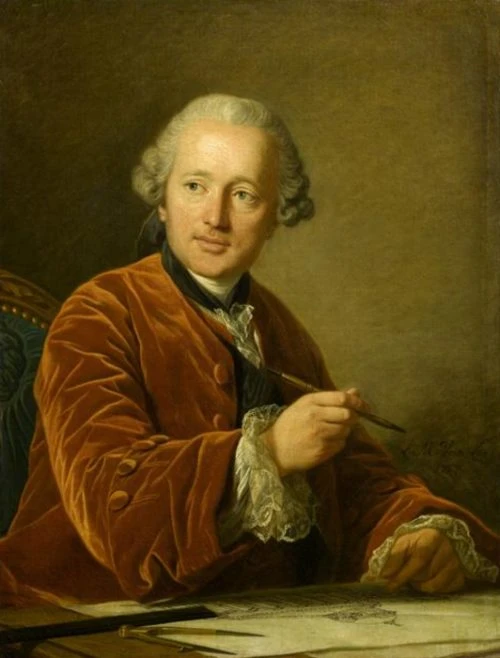
Jacques Germain SOUFFLOT (1713-1780) by Van LOO. Photo chosen by monsieurdefrance.com: wikicommons.
"Aux grands hommes, la Patrie reconnaissante" (To great men, a grateful country)
It was Emmanuel de PASTHORET (1755-1840), first president of the Legislative Assembly, who launched the idea of a place to bury great men. The Saint Geneviève church, barely completed, was desacralized. Religious symbols were removed, and most of the windows were closed to create the half-light necessary for contemplation. On April 4, 1791, the Pantheon was born. MIRABEAU's death inspired the idea.
First in, first out of the Pantheon
Mirabeau. Portrait selected by monsieurdefrance.com: Joseph BOZE via Wikipedia/wikicommons.
In 1791, at the height of his fame, Honoré Gabriel RIQUETTI de MIRABEAU (1749-1791) died. He was much loved by Parisians, and the question of his burial place arose. It was on this occasion that PASTHORET proposed to desecrate the church of Sainte Geneviève and turn it into a Pantheon, like the one in Rome, originally dedicated to all the gods and now the burial place of Roman geniuses (like Raphael). The proposal was adopted and MIRABEAU was buried there, on April 5, 1791, after a religious ceremony in the church of Saint Eustache, proving, if proof were needed, that Sainte Geneviève was no longer a church but the Pantheon from the day before. A little over a year later, the discovery of the iron cabinet changed everything. In this cupboard in the Château des Tuileries, Louis XVI had taken to keeping his secret papers. MIRABEAU figures prominently in the list of personalities purchased by the king. In fact, he played a double game. A revolutionary in the Assemblée Nationale, he advised Louis XVI and Marie-Antoinette in the shadows, in return for money. As a result, on September 21, 1794, his body was removed from the Pantheon and his ashes disappeared, meaning he would never return. He was replaced by Jean Paul MARAT (1743-1793), who remained there for just 2 years before he too was expelled at the end of the French Revolution. They are both the shortest-lived members of the Pantheon to date.
Several assignments later
In 1867, the Second Empire restored the church's function while maintaining the idea of the Pantheon. Period engraving.
On February 20, 1806, the Empire continued to use the Pantheon as a burial place for illustrious figures, but also re-established its use as a church. A cross was installed at the top of the dome. On its return to power, the Monarchy abolished the Pantheon's use as a secular site and re-established its use solely as the church of Sainte Geneviève, but in 1830 the July Monarchy re-established the Pantheon without the church . The pediment is rebuilt by DAVID. After becoming a church again during the 2nd Empire (1852-1871), in 1883 the Pantheon once again became the burial place reserved by the Patrie for great men . Its use has remained unchanged ever since.
Who lies at the Pantheon?
6 women are buried at the Panthéon, including :
The most recent: Joséphine BAKER (1906-1975) Born American, became French. Singer, dancer and resistance fighter.
The first: Marie CURIE (1867-1934) Born Polish, became French. Two-time Nobel Prize-winning scientist (irradiated, her body was sealed in a lead coffin).
Germaine TILLON (1907-2008). French ethnologist and resistance fighter.
Geneviève de GAULLE-ANTHONIOZ (1920-2002). Campaigner for human rights and against poverty. Resistance fighter.
Simone VEIL (1927-2017). Minister, first President of the European Parliament.
Two people at the same time:
Marc SCHOELCHER (politician) was laid to rest with his son Victor SCHOELCHER (journalist), following their joint wish to be laid to rest in the same place. Similarly, Sophie BERTHELOT is laid to rest with her husband Marcellin BERTHELOT (chemist), who died an hour after his wife, so overcome was he with grief.
The transfer of VOLTAIRE's ashes to the Panthéon. Period engraving. By Jean-Louis Prieur/Christophe Müller - musée de la Révolution française, CC BY-SA 4.0, https://commons.wikimedia.org/w/index.php?curid=64284707
Famous men including :
The transfer of Emile ZOLA's ashes to the Panthéon in 1908. Image chosen by Monsieurdefrance.com: BNF/Gallica.fr
Among others: Jean MOULIN (1899-1943), Resistance fighter, VOLTAIRE (1694-1778), philosopher, Emile ZOLA (1840-1902) journalist, writer, Jean Jacques ROUSSEAU (1712-1778), philosopher (1712-1778), Victor HUGO (1802-1885), Jean JAURES(1859-1914) journalist and politician, Louis Antoine de BOUGAINVILLE (1729-1811), Louis BRAILLE (1909-1852) inventor of the Braille alphabet, Sadi CARNOT (1837-1894) murdered politician, René CASSIN (1887-1976) resistance fighter and politician, Pierre CURIE (1859-1906) scientist, Alexandre DUMAS (1802-1870) writer, Léon GAMBETTA (1838-1882) politician, and Jacques Germain SOUFFLOT (1713-1780) architect of the Panthéon.
Jean MOULIN, whose entry into the Panthéon, presided over by General de GAULLE, was the occasion of a magnificent speech by André MALRAUX (1901-1976), image chosen by Monsieurdefrance.com; photograph by the Harcourt studio in 1937.
They came out of Pantheon
Honoré Gabriel RIQUETI de MIRABEAU (1749-1791), Louis Michel LEPELETIER de SAINT-FARGEAU (1760-1793) Auguste Marie PICOT de DAMPIERRE (1756-1793), Jean Paul MARAT (1743-1793).
The colonnade of the Pantheon photo chosen by monsieurdefrance.com: depositphotos.
The Pantheon in 3 anecdotes
1 It was used for the first radio link.
In 1898, Eugène DUCRETET and Ernest ROGER transmitted a Morse code message wirelessly to the Eiffel Tower for the first time. It was the first radio broadcast in France. The link literally saved the Eiffel Tower, which was to be dismantled after the 1889 Universal Exhibition, and gave it a new vocation as an antenna. This is still the case today.
2 He almost welcomed the Unknown Soldier
After the First World War, the idea of a tomb for the Unknown Soldier, in homage to those who died for France, was mooted. The Panthéon was first proposed, before, under pressure from veterans' associations, the Arc de Triomphe was finally chosen.
3 André MALRAUX's cat
André MALRAUX (1901-1976), a French minister, is buried in the Panthéon. He wanted one of them to be represented, and so it is. A bronze cat stands in front of his tomb.
What to see around the Pantheon
The Pantheon seen from afar. Photo chosen by monsieurdefrance.com: Dialiu via dépositphotos.com
The "quartier latin"
The Panthéon is located in the famous Latin Quarter, an area of Paris that owes its name to the fact that students there studied in Latin. It's also home to the Sorbonne, for example. An often turbulent area, particularly in May 1968, with numerous student demonstrations. The Latin Quarter is also home to the Palais du Luxembourg, seat of the French Senate, and the Grande Mosquée de Paris.
The Sorbonne
The façade of the Sorbonne church. Photo chosen by monsieurdefrance.com: RicoK. via depositphotos.com
The Sorbonne takes its name from Robert de SORBON. He founded a theological college with the aim of "living in good society, collegially, morally and studiously". The church was built by Cardinal de RICHELIEU , whose portrait hangs in one of the university's salons. The cardinal is also buried here.
Sorbonne address: 19 rue de la Sorbonne. Tours are available (between 7 and 15 euros per person). A virtual tour is available here.
The Luxembourg Palace
The façade of the Palais du Luxembourg on the garden side. Photos selected by monsieurdefrance.com vkovalcik via depositphotos.
The Palais du Luxembourg is the seat of the French Senate. The High Assembly has been housed here since 1799, with different names and functions depending on France's political situation. Designed by architect Salomon de BROSSE (1565-1628), it was built between 1615 and 1630 for Queen Marie de MEDICIS. The interior was extensively remodeled in the 19th century. The Luxembourg gardens are very popular with Parisians and tourists alike. The Senate maintains this 22-hectare garden, which is open to the public. It features 106 statues, including those of the queens of France. A British magazine named it the most beautiful garden in Europe.
Luxembourg Gardens address: place Edmond Rostand, place André Honnorat, rue Guynemer. Senate entrance: 15 rue de Vaugirard
Students love the lawns of the Palais du Luxembourg gardens in fine weather. Photo chosen by monsieurdefrance.com: JanKranendonk via depositphotos
Boulevard Saint Michel
Boulevard Saint Michel is well worth a detour. It takes you right down to the Seine. It is typically Haussmannian. Its best-known landmark is the Fontaine Saint Michel. Completed in 1860, it occupies the entire front of a building and depicts the archangel Saint Michel, leader of the celestial militia, slaying the dragon. It's right next to the "Saint Michel" metro station.
The Saint Michel fountain. Photo chosen by monsieurdefrance.com: jmbf via depositphotos.
How do I get to the Pantheon?
Pantheon address
Place du panthéon / 75 005 PARIS
Nearest parking lot: Parking SOUFFLOT: 22 rue Soufflot.
Metro
Line 10 Cardinal Lemoine station. Line 7, Jussieu station.
RER
Line B: Luxembourg station (10-minute walk).
Bus
21 / 27 / 38 / 82 / 84 / 85 /89
The Pantheon. Photo chosen by monsieurdefrance.com: mix7777 via dépositphotos.com
Schedules / Rates / Web
Opening hours
April1 to September 30: 10H00 - 18H30
October1 to March 31: 10H00 - 18H00
Closed: January 1 / May 1 / December 25
Rates
11.50 full price, with an additional €3.50 for the panoramic view. A combined ticket is also available to visit the Royal Basilica of Saint Denis. Different rates are available (students, groups, EU citizens, etc.). Rates 2023, check on the official website.
Website

